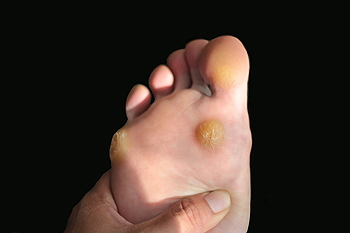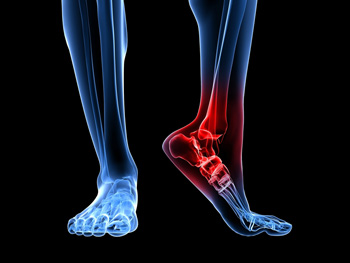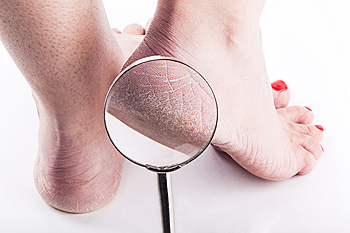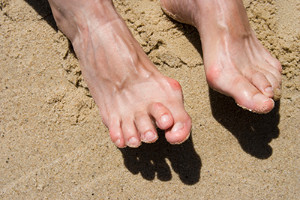
 If you notice a hardened area of skin on the bottom or side of your foot, you may have developed a foot condition that is known as a corn. Corns, often confused with calluses, are rounder and incredibly sensitive to the touch when pressure is applied. Corns may develop due to an intense amount of friction between the skin on your feet and tightly worn shoes, for example high heels. Some patients have found mild relief from the discomfort by using apple cider vinegar and castor oil, vitamin E, lemon peels, and Epsom salts. If you would like to safely remove your corn, and get advice on how to best treat this condition, it is suggested that you seek the counsel of a podiatrist.
If you notice a hardened area of skin on the bottom or side of your foot, you may have developed a foot condition that is known as a corn. Corns, often confused with calluses, are rounder and incredibly sensitive to the touch when pressure is applied. Corns may develop due to an intense amount of friction between the skin on your feet and tightly worn shoes, for example high heels. Some patients have found mild relief from the discomfort by using apple cider vinegar and castor oil, vitamin E, lemon peels, and Epsom salts. If you would like to safely remove your corn, and get advice on how to best treat this condition, it is suggested that you seek the counsel of a podiatrist.
If you have any concerns about your feet, contact Dr. Stephan J. LaPointe from Georgia Foot & Ankle Specialists . Our doctor can provide the care you need to keep you pain-free and on your feet.
Biomechanics in Podiatry
Podiatric biomechanics is a particular sector of specialty podiatry with licensed practitioners who are trained to diagnose and treat conditions affecting the foot, ankle and lower leg. Biomechanics deals with the forces that act against the body, causing an interference with the biological structures. It focuses on the movement of the ankle, the foot and the forces that interact with them.
A History of Biomechanics
Modern technological improvements are based on past theories and therapeutic processes that provide a better understanding of podiatric concepts for biomechanics. Computers can provide accurate information about the forces and patterns of the feet and lower legs.
Understanding biomechanics of the feet can help improve and eliminate pain, stopping further stress to the foot.
If you have any questions please feel free to contact our office located in Rome, GA . We offer the newest diagnostic and treatment technologies for all your foot and ankle needs.
 If you feel a tingling, burning, or numbing sensation in your feet, you may be experiencing symptoms related to a foot condition known as tarsal tunnel syndrome. With this condition, pain is typically felt in the sole, heel, and arch areas of the foot. Some patients who have had this condition also say they experienced a sensation that feels like pins and needles in the feet. Tarsal tunnel syndrome may develop when the posterior tibial nerve becomes compressed or pinched. Other reasons for its development may include osteoarthritis, rheumatoid arthritis, and diabetes. To help alleviate pain, it may be beneficial to perform light stretches that focus on strengthening the calf muscles. For more advice on how to treat this ailment, it’s suggested that you speak with a podiatrist for a proper diagnosis and professional care.
If you feel a tingling, burning, or numbing sensation in your feet, you may be experiencing symptoms related to a foot condition known as tarsal tunnel syndrome. With this condition, pain is typically felt in the sole, heel, and arch areas of the foot. Some patients who have had this condition also say they experienced a sensation that feels like pins and needles in the feet. Tarsal tunnel syndrome may develop when the posterior tibial nerve becomes compressed or pinched. Other reasons for its development may include osteoarthritis, rheumatoid arthritis, and diabetes. To help alleviate pain, it may be beneficial to perform light stretches that focus on strengthening the calf muscles. For more advice on how to treat this ailment, it’s suggested that you speak with a podiatrist for a proper diagnosis and professional care.
Tarsal tunnel syndrome can be very uncomfortable to live with. If you are experiencing tarsal tunnel syndrome, contact Dr. Stephan J. LaPointe of Georgia Foot & Ankle Specialists . Our doctor can provide the care you need to keep you pain-free and on your feet.
Tarsal Tunnel Syndrome
Tarsal tunnel syndrome, which can also be called tibial nerve dysfunction, is an uncommon condition of misfiring peripheral nerves in the foot. The tibial nerve is the peripheral nerve in the leg responsible for sensation and movement of the foot and calf muscles. In tarsal tunnel syndrome, the tibial nerve is damaged, causing problems with movement and feeling in the foot of the affected leg.
Common Cause of Tarsal Tunnel Syndrome
The Effects of Tarsal Tunnel Syndrome
A physical exam of the leg can help identify the presence of tarsal tunnel syndrome. Medical tests, such as a nerve biopsy, are also used to diagnose the condition. Patients may receive physical therapy and prescriptive medication. In extreme cases, some may require surgery.
If you have any questions please feel free to contact our office located in Rome, GA . We offer the newest diagnostic and treatment technologies for all your foot and ankle needs.
 The medical condition that is known as cracked heels is defined as splits in the skin that may gradually develop into deep fissures. This may cause pain and discomfort, and in severe cases, the skin may begin to bleed. Common symptoms that are associated with this ailment can include hardened and itchy skin, and it may be difficult to walk. This condition may develop from standing for extended periods of time throughout the day, or from frequently wearing shoes that have an open back. Some patients have found mild relief when the feet are washed and dried, followed by using a good moisturizer. Additionally, it may be beneficial to drink plenty of water on a daily basis, and to implement a gentle exercise routine. If you are afflicted with cracked heels, it is strongly advised that you speak with a podiatrist who can properly treat this condition.
The medical condition that is known as cracked heels is defined as splits in the skin that may gradually develop into deep fissures. This may cause pain and discomfort, and in severe cases, the skin may begin to bleed. Common symptoms that are associated with this ailment can include hardened and itchy skin, and it may be difficult to walk. This condition may develop from standing for extended periods of time throughout the day, or from frequently wearing shoes that have an open back. Some patients have found mild relief when the feet are washed and dried, followed by using a good moisturizer. Additionally, it may be beneficial to drink plenty of water on a daily basis, and to implement a gentle exercise routine. If you are afflicted with cracked heels, it is strongly advised that you speak with a podiatrist who can properly treat this condition.
Cracked heels are unsightly and can cause further damage to your shoes and feet. If you have any concerns, contact Dr. Stephan J. LaPointe from Georgia Foot & Ankle Specialists . Our doctor can provide the care you need to keep you pain-free and on your feet.
Cracked Heels
Cracked heels appear unappealing and can make it harder for you walk around in sandals. Aside from looking unpleasant, cracked heels can also tear stockings, socks, and wear out your shoes. There are several methods to help restore a cracked heel and prevent further damage.
How Do You Get Them?
Dry skin is the number one culprit in creating cracked heels. Many athletes, walkers, joggers, and even swimmers suffer from cracked heels. Age and skin oil production play a role to getting cracked heels as well.
Promote Healing
Over the counter medicines can help, especially for those that need instant relief or who suffer from chronic dry feet.
Wear Socks – Wearing socks with medicated creams helps lock in moisture.
Moisturizers – Applying both day and night will help alleviate dryness which causes cracking.
Pumice Stones – These exfoliate and remove dead skin, which allows for smoother moisturizer application and better absorption into the skin.
Change in Diet
Eating healthy with a well-balanced diet will give the skin a fresh and radiant look. Your body responds to the kinds of food you ingest. Omega-3 fatty acids and zinc supplements can also revitalize skin tissue.
Most importantly, seek professional help if unsure how to proceed in treating cracked heels. A podiatrist will help you with any questions or information needed.
If you have any questions, please feel free to contact our office located in Rome, GA . We offer the newest diagnostic and treatment technologies for all your foot care needs.
One of the most important things elderly people can do is to properly care for their feet. Many seniors can experience uncomfortable foot conditions as a result of a loss of cushioning as the aging process occurs. Research has indicated that one of the most favorable things seniors can do for their feet is wear shoes that fit correctly. The feet will feel better when there is adequate room for the toes to move freely in, and this may be helpful in preventing corns and bunions from developing. Additionally, washing and drying the feet daily followed by using a good moisturizer may be beneficial in preventing cracked heels. If you would like additional information about how elderly patients can care for their feet, please consult with a podiatrist.
Proper foot care is something many older adults forget to consider. If you have any concerns about your feet and ankles, contact Dr. Stephan J. LaPointe from Georgia Foot & Ankle Specialists . Our doctor can provide the care you need to keep you pain-free and on your feet.
The Elderly and Their Feet
As we age we start to notice many changes in our body, but the elder population may not notice them right away. Medical conditions may prevent the elderly to take notice of their foot health right away. Poor vision is a lead contributor to not taking action for the elderly.
Common Conditions
Susceptible Infections
Diabetes and poor circulation can cause general loss of sensitivity over the years, turning a simple cut into a serious issue.
If you have any questions please feel free to contact our office located in Rome, GA . We offer the newest diagnostic and treatment technologies for all your foot and ankle needs.
There are clear signs that can indicate whether athlete's foot has developed or not. A common symptom related to this condition is the formation of a red rash that may spread all over the afflicted foot and is normally found in between the toes. If left untreated, the rash may spread underneath the foot, leaving the skin looking scaly or chalky. Additionally, the rash may be incredibly itchy, however, scratching the affected area may cause more harm to the skin, which is why it is advised that scratching be refrained. Athlete’s foot is a fungal skin infection that may enter the skin if footwear is not worn in warm, moist environments. Areas where this infection typically spreads can include communal showers, locker rooms, and swimming pools. For advice on how to treat your athlete’s foot or for tips on prevention, we recommend you consult with a podiatrist for professional care.
Athlete’s Foot
Athlete’s foot is often an uncomfortable condition to experience. Thankfully, podiatrists specialize in treating athlete’s foot and offer the best treatment options. If you have any questions about athlete’s foot, consult with Dr. Stephan J. LaPointe from Georgia Foot & Ankle Specialists . Our doctor will assess your condition and provide you with quality treatment.
What Is Athlete’s Foot?
Tinea pedis, more commonly known as athlete’s foot, is a non-serious and common fungal infection of the foot. Athlete’s foot is contagious and can be contracted by touching someone who has it or infected surfaces. The most common places contaminated by it are public showers, locker rooms, and swimming pools. Once contracted, it grows on feet that are left inside moist, dark, and warm shoes and socks.
Prevention
The most effective ways to prevent athlete’s foot include:
Symptoms
Athlete’s foot initially occurs as a rash between the toes. However, if left undiagnosed, it can spread to the sides and bottom of the feet, toenails, and if touched by hand, the hands themselves. Symptoms include:
Diagnosis and Treatment
Diagnosis is quick and easy. Skin samples will be taken and either viewed under a microscope or sent to a lab for testing. Sometimes, a podiatrist can diagnose it based on simply looking at it. Once confirmed, treatment options include oral and topical antifungal medications.
If you have any questions, please feel free to contact our office located in Rome, GA . We offer the newest diagnostic and treatment technologies for all your foot care needs.
 When the middle joint in a toe looks deformed, it may be indicative of a condition that is known as hammertoe. Hammertoe occurs as a result of an imbalance in the soft tissues of the affected toe, and may cause swelling and discomfort. Additional symptoms may consist of redness surrounding the toe, and difficulty moving or straightening the toe. The affected toe typically bends downward, resembling a hammer, and a corn may form on top of it as shoes are worn as well. This condition may happen from a genetic muscle imbalance, if shoes that are worn have inadequate room for the toes to move freely in, or if the toe has endured an injury. There are several ways to treat hammertoe. If you are afflicted with this condition, it is strongly advised that you seek the counsel of a podiatrist who can begin the best type of treatment for you.
When the middle joint in a toe looks deformed, it may be indicative of a condition that is known as hammertoe. Hammertoe occurs as a result of an imbalance in the soft tissues of the affected toe, and may cause swelling and discomfort. Additional symptoms may consist of redness surrounding the toe, and difficulty moving or straightening the toe. The affected toe typically bends downward, resembling a hammer, and a corn may form on top of it as shoes are worn as well. This condition may happen from a genetic muscle imbalance, if shoes that are worn have inadequate room for the toes to move freely in, or if the toe has endured an injury. There are several ways to treat hammertoe. If you are afflicted with this condition, it is strongly advised that you seek the counsel of a podiatrist who can begin the best type of treatment for you.
Hammertoes can be a painful condition to live with. For more information, contact Dr. Stephan J. LaPointe of Georgia Foot & Ankle Specialists . Our doctor will answer any of your foot- and ankle-related questions.
Hammertoe
Hammertoe is a foot deformity that occurs due to an imbalance in the muscles, tendons, or ligaments that normally hold the toe straight. It can be caused by the type of shoes you wear, your foot structure, trauma, and certain disease processes.
Symptoms
Risk Factors
Treatment
If you have hammertoe, you should change into a more comfortable shoe that provides enough room for your toes. Exercises such as picking up marbles may strengthen and stretch your toe muscles. Nevertheless, it is important to seek assistance from a podiatrist in order to determine the severity of your hammertoe and see which treatment option will work best for you.
If you have any questions, please feel free to contact our office located in Rome, GA . We offer the newest diagnostic and treatment technologies for all your foot care needs.
 Heel pain is a condition that many patients experience, and it may be caused due to a variety of reasons. The medical ailment that is known as plantar fasciitis is a common cause of heel pain, and can be extremely uncomfortable. Additionally, a tear or injury to the Achilles tendon may cause sharp pain that is felt in the calf and the heel. If an injury has occurred, moderate relief may be found when the foot is elevated, and the affected area is given rest as often as possible. For severe heel pain, it is strongly advised that you consult with a podiatrist as quickly as possible to determine the cause, and allow for proper treatment to begin.
Heel pain is a condition that many patients experience, and it may be caused due to a variety of reasons. The medical ailment that is known as plantar fasciitis is a common cause of heel pain, and can be extremely uncomfortable. Additionally, a tear or injury to the Achilles tendon may cause sharp pain that is felt in the calf and the heel. If an injury has occurred, moderate relief may be found when the foot is elevated, and the affected area is given rest as often as possible. For severe heel pain, it is strongly advised that you consult with a podiatrist as quickly as possible to determine the cause, and allow for proper treatment to begin.
Many people suffer from bouts of heel pain. For more information, contact Dr. Stephan J. LaPointe of Georgia Foot & Ankle Specialists . Our doctor can provide the care you need to keep you pain-free and on your feet.
Causes of Heel Pain
Heel pain is often associated with plantar fasciitis. The plantar fascia is a band of tissues that extends along the bottom of the foot. A rip or tear in this ligament can cause inflammation of the tissue.
Achilles tendonitis is another cause of heel pain. Inflammation of the Achilles tendon will cause pain from fractures and muscle tearing. Lack of flexibility is also another symptom.
Heel spurs are another cause of pain. When the tissues of the plantar fascia undergo a great deal of stress, it can lead to ligament separation from the heel bone, causing heel spurs.
Why Might Heel Pain Occur?
Treatments
Heel pain should be treated as soon as possible for immediate results. Keeping your feet in a stress-free environment will help. If you suffer from Achilles tendonitis or plantar fasciitis, applying ice will reduce the swelling. Stretching before an exercise like running will help the muscles. Using all these tips will help make heel pain a condition of the past.
If you have any questions please contact our office located in Rome, GA . We offer the newest diagnostic and treatment technologies for all your foot and ankle needs.
When fungi gets underneath the toenail, it’s very likely for toenail fungus to form. In order to tell if you have toenail fungus, it’s important you look out for certain signs. Common symptoms of this condition may include discoloration, thickening, or lifting of the nail. In some cases, it’s also been known for fungus to cause the affected toenail to crumble or split. As far as developing toenail fungus, certain factors may increase your likelihood. These factors may include living in a hot or humid climate, having athlete’s foot, being diabetic, spending a lot of time in the water, wearing tightly fitted shoes that cause the feet to sweat excessively, and having a weak immune system. If you feel you might have developed toenail fungus, it’s important you seek help as soon as possible. We recommend you consult with a podiatrist for a proper diagnosis and advised treatment plan.
For more information about treatment, contact Dr. Stephan J. LaPointe of Georgia Foot & Ankle Specialists . Our doctor can provide the care you need to keep you pain-free and on your feet.
Toenail Fungus Treatment
Toenail fungus is a condition that affects many people and can be especially hard to get rid of. Fortunately, there are several methods to go about treating and avoiding it.
Antifungals & Deterrence
Oral antifungal medicine has been shown to be effective in many cases. It is important to consult with a podiatrist to determine the proper regiment for you, or potentially explore other options.
Applying foot powder on the feet and shoes helps keep the feet free of moisture and sweat.
Sandals or open toed shoes – Wearing these will allow air movement and help keep feet dry. They also expose your feet to light, which fungus cannot tolerate. Socks with moisture wicking material also help as well.
If you have any questions please feel free to contact our office located in Rome, GA . We offer the newest diagnostic tools and technology to treat your foot and ankle needs.